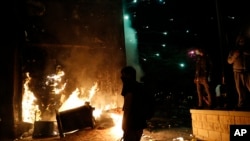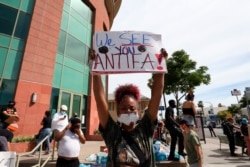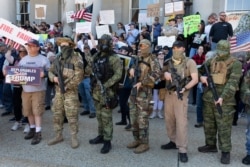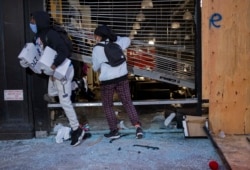The daytime protests this week across the United States have been largely peaceful, consisting of people drawn from all racial backgrounds and all walks of life, young and old. They have including mothers fearful that what befell George Floyd -- an African-American man who died in police custody after a white police officer knelt on his neck for more than eight minutes -- could all too easily happen to their sons.
But many of the nights since Floyd’s death have been different, full of rampant pillaging, arson and vandalism and brawling with police. There have been isolated incidents of shots being fired at police. In their turn, protesters blame police for heavy-handed tactics and say they are merely defending themselves.
Who’s behind the violence?
President Donald Trump and some of his top officials accuse “radical left” agitators for the mayhem. U.S. Attorney General William Barr points the finger at “far-left extremist groups” including Antifa, a network of confrontational, autonomous far-left groups.
Some Democratic governors have in turn blamed far-right groups, highlighting an announcement this week by social-media giant Twitter that it had suspended an account linked to a white nationalist group, Identity Evropa, for inciting violence.
The account was set up with a fake Antifa profile and was linked to other false-flag accounts that pumped out provocative false information accusing authorities and internet providers of censoring protest news. Facebook also announced this week it had suspended several accounts linked to white nationalist groups after they urged people to bring weapons to protests in the U.S.
Meanwhile, members of the so-called “Boogaloo” movement -- an amorphous collective with far-right and far-left elements -- were seen at protests in some states, wearing their signature Hawaiian shirts, including in Minnesota, Texas and Pennsylvania. Some “Boogaloo” adherents are part of a broader movement of white supremacists called “accelerationists,” who welcome civil disorder and want to foment violent political polarization, hoping it will end up toppling America’s current political order.
Researchers at the Counter Extremism Project, an international policy organization formed to monitor and combat extremist groups, say white supremacists and neo-Nazis have been celebrating the past week of mayhem on the streets. On the Telegram channel of one violent neo-Nazi group, 5,500 followers reportedly were advised that a large protest would provide the perfect opportunity to commit a murder. Another Telegram channel said the time was right to attack synagogues with law enforcement being distracted by the civil unrest, according to CEP.
But it is unclear to what extent radical groups of left or right have been able to orchestrate violence.
New York’s deputy commissioner for intelligence and counterterrorism, John Miller, believes anarchist and radical left groups have been stoking the fury in his city. “Before the protests began,” he told reporters, “organizers of certain anarchist groups set out to raise bail money and people who would be responsible to be raising bail money, they set out to recruit medics and medical teams with gear to deploy in anticipation of violent interactions with police.”
He added: “They prepared to commit property damage and directed people who were following them that this should be done selectively and only in wealthier areas or at high-end stores run by corporate entities.” One in seven of those arrested in New York for public order offenses has been from outside the city, which officials say is suspicious.
Law enforcement officials in several other states and cities contacted by VOA say they believe out-of-state actors seeded themselves within the overwhelmingly non-violent local community protesters. But they acknowledge they’re still trying to assess how much those agitators have been able to steer the course of events on the streets. Some officials say it doesn’t take much to spark conflagration and prod agitated, passionate crowds, setting up a reciprocal cycle of violence.
Analysts and researchers who follow radical groups say they have little doubt extremists were involved in the much bigger stew of unrest, anger and protest. “It will take time to unravel what extremist networks may or may not have been involved,” Brian Levin, a professor of criminal justice at California State University-San Bernardino and director of the Center for the Study of Hate & Extremism, told VOA.
“Some people being arrested appear to be affiliated to the hard left, but others seem to be from the far right. Some of these folks might just be thrill-seeking manipulators or are felonious opportunists and not just ideologues, others are idiosyncratic wildcards,” he added. Distinguishing between them all can be difficult.
“But we have a very fragmented and splintered socio-political landscape in America now, and with institutions under stress, a pandemic and an election year underway, I really think we have to reassess what the threat matrix. There is a deep reservoir of potential extremist recruits,” he adds.








